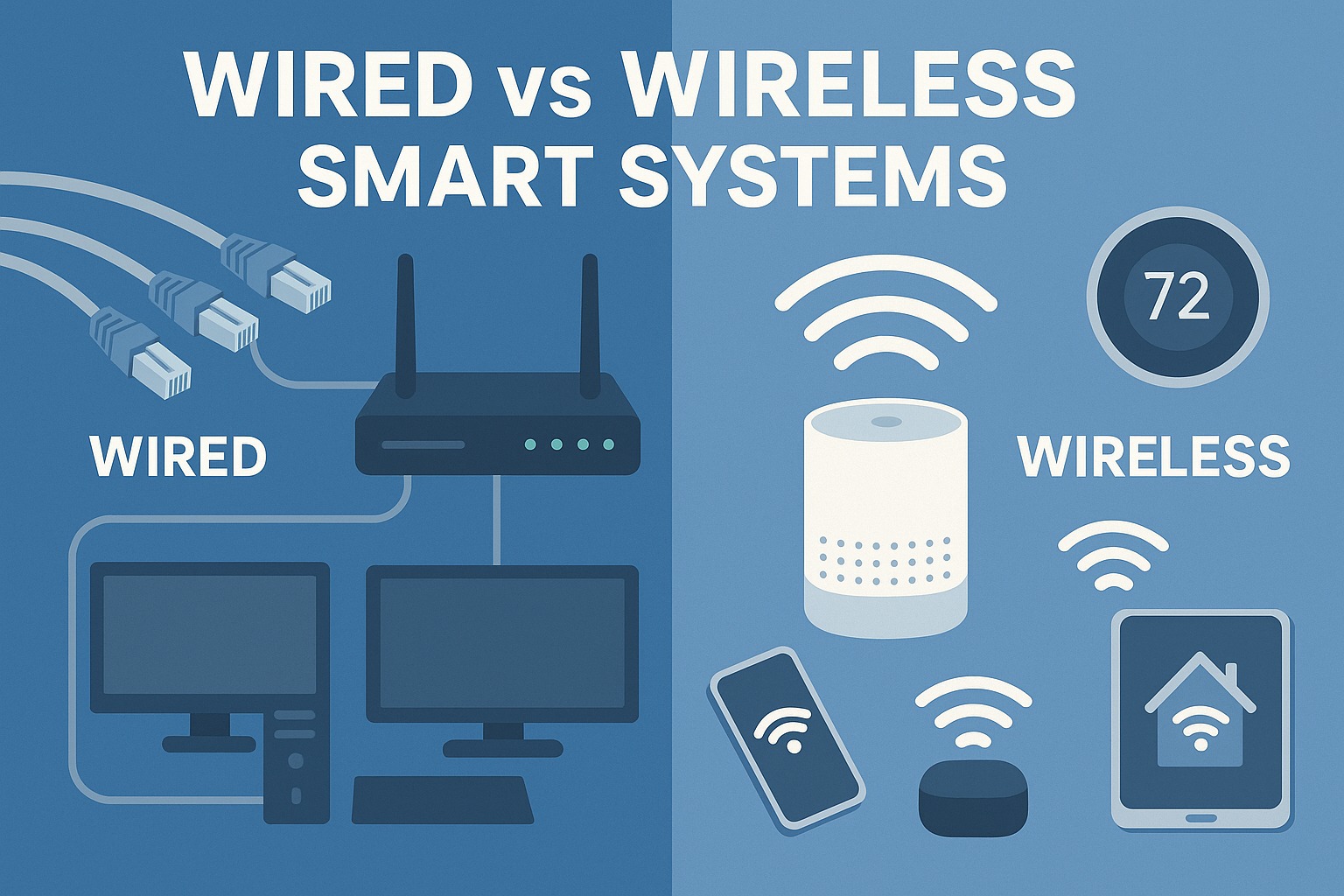Choosing between a wired vs wireless smart system is one of the first decisions you’ll face when building a smart home setup. While both offer home automation and device control, they work in fundamentally different ways—and each comes with its own strengths and challenges.
Wired smart systems use physical cables and centralized hubs to connect your devices, making them ideal for stable, long-term installations. On the other hand, wireless smart systems rely on Wi-Fi, Zigbee, or Bluetooth to link your gadgets—offering flexibility, scalability, and easy DIY setup for modern lifestyles.
Wired smart systems use physical cables for device communication, offering reliability and speed, while wireless smart systems rely on Wi-Fi, Bluetooth, or Zigbee for flexible and easy installation. Wired systems are ideal for permanent setups with high security needs, whereas wireless options suit renters or those seeking plug-and-play convenience.
In this guide, we’ll break down the differences between wired and wireless smart home systems, compare their pros and cons, and help you decide which option fits your needs—whether you’re building from scratch, upgrading an apartment, or looking for the most secure smart home network.
What Are Wired Smart Systems?
Wired smart systems are home automation setups where all your smart devices—like lights, cameras, thermostats, and sensors—are connected through physical cables, typically Ethernet or dedicated wiring. These systems rely on hardwired infrastructure rather than Wi-Fi, which gives them a major edge in terms of stability, speed, and reliability.
Think of wired smart systems as the backbone of professional-grade home automation. You’ll often find them in newly constructed homes, luxury residences, or buildings where long-term performance and security are top priorities. Because they don’t depend on wireless signals, these setups avoid issues like signal interference or dropped connections—common problems in wireless smart home networks.
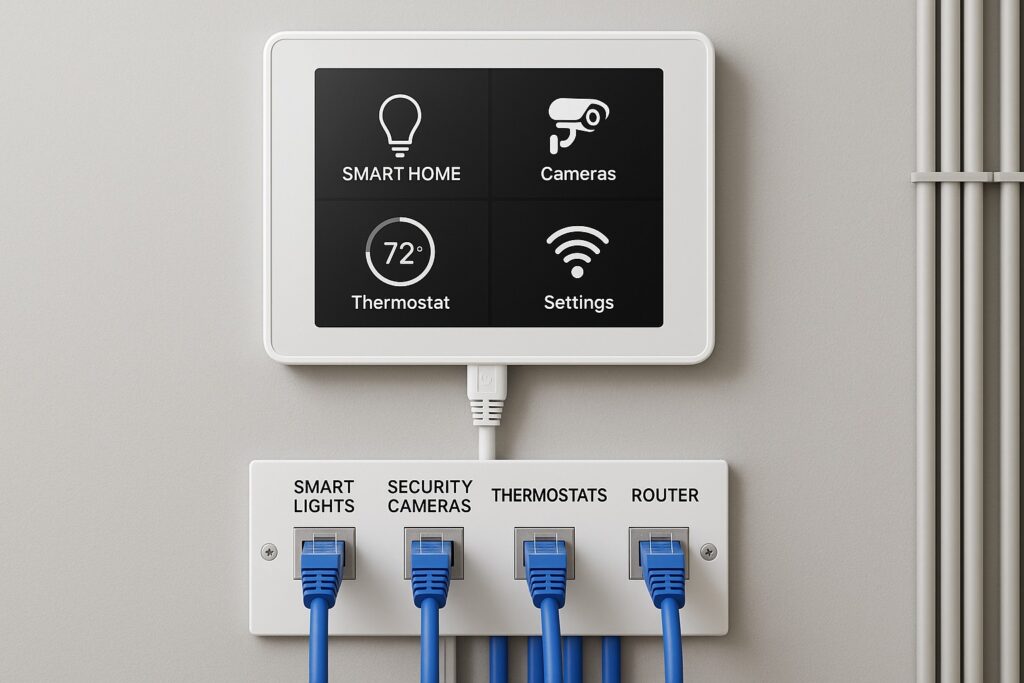
Popular protocols used in wired systems include:
- Ethernet (for internet-based control)
- KNX (a professional-grade home automation standard)
- RS-485 or Modbus (used in industrial and high-end smart home setups)
While the installation is more complex and often requires a professional, wired systems offer a centralized and seamless automation experience—especially useful for large homes, multi-story buildings, or smart offices where data flow and security matter.
If you’re planning a full-blown smart home from the ground up and don’t mind the upfront cost or construction work, a wired system may be the most future-proof and high-performance option available.
What Are Wireless Smart Systems?
Wireless smart systems are the go-to choice for anyone who wants a fast, flexible way to set up a smart home—without dealing with physical cables or complicated installations. These systems connect your devices using wireless communication protocols like Wi-Fi, Bluetooth, Zigbee, or Z-Wave, allowing them to “talk” to each other and be controlled remotely through a mobile app or smart hub.

This kind of setup is perfect for renters, apartment dwellers, or homeowners who want to avoid rewiring their space. You can easily add or remove devices—like smart bulbs, wireless security cameras, smart plugs, or voice assistants—without needing professional help. Everything syncs through your existing home Wi-Fi network or via mesh-based communication like Zigbee or Z-Wave for better range and performance.
Wireless smart systems shine when it comes to DIY-friendly smart home automation. They’re often plug-and-play, making it easy to build a scalable and customizable setup that grows with your needs. However, they do rely on strong wireless signals. If your Wi-Fi is weak or crowded, you might face occasional lags or connection drops.
Still, for most people—especially those just starting their smart home journey—wireless smart systems offer the perfect blend of ease, affordability, and control.
Key Differences Between Wired and Wireless Smart Systems
When building a smart home, one of the most important decisions you’ll make is whether to go with a wired or wireless system. While both can power up your automation dreams, they operate very differently—and each has its own strengths and trade-offs. Let’s break down the core differences in terms that actually matter in real life.
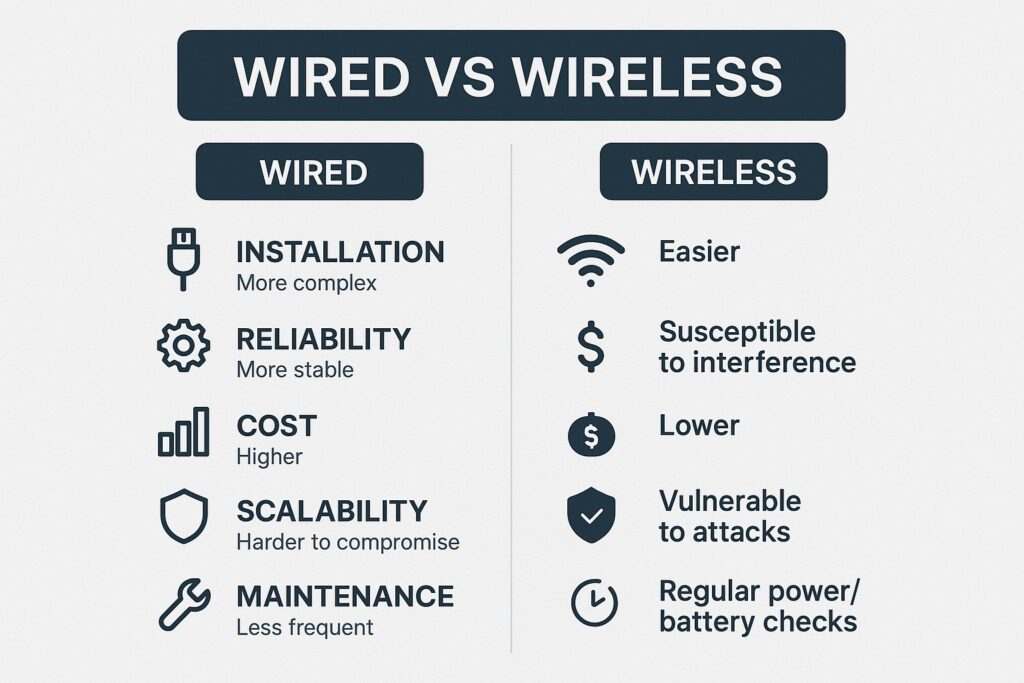
Installation Process and Complexity
Wired systems require running physical cables through your walls, floors, or ceilings. That means you’ll likely need a professional installer, especially for larger setups or new builds. This makes wired systems more suitable for homeowners or those doing major renovations.
Wireless systems, on the other hand, are much easier to install. Most are plug-and-play smart devices that connect to your existing Wi-Fi or smart hub. They’re ideal for renters, apartments, or anyone who prefers a DIY smart home setup.
Reliability and Signal Stability
Wired systems win in terms of stability. Since the data travels through cables, there’s minimal risk of signal dropouts or interference. This is why wired automation systems are popular in security-heavy or enterprise-level smart homes.
Wireless systems can be reliable too—but they depend on the strength of your Wi-Fi or mesh network. Interference from other devices or thick walls may affect performance. Zigbee and Z-Wave smart protocols help reduce these issues, but wired is still king when reliability is mission-critical.
Cost Comparison
Wired systems often come with higher upfront costs. You’ll pay for the cabling, installation, and sometimes even for a control panel or custom setup. But over time, they can be more energy-efficient and require less maintenance.
Wireless systems are typically more affordable to start with. You can buy individual devices and expand as needed. They’re a great option for budget-friendly smart homes or people just testing the waters.
Scalability and Upgrades
Wireless systems are highly scalable. Adding a new smart plug, speaker, or camera is as easy as syncing it to your app. This flexibility makes them ideal for growing families or evolving home setups.
Wired systems are harder to scale once installed. Adding new devices often means more cables and possibly construction work. However, they tend to be more future-proof when designed properly from the start.
Security and Privacy
Wired smart systems are inherently more secure since data travels through a closed circuit. They’re less vulnerable to hacking and data breaches—perfect for homes with high-security needs or sensitive systems.
Wireless systems, while convenient, can be more exposed to cyber threats if not properly secured. Strong passwords, two-factor authentication, and encrypted communication protocols like WPA3 can help protect your network.
Maintenance and Troubleshooting
Troubleshooting wired systems usually means checking physical connections or replacing hardware. It’s often more technical but less frequent.
Wireless systems might require you to reset devices, reconnect to Wi-Fi, or update apps. While easier for beginners, they can sometimes be less consistent over time—especially in Wi-Fi-congested homes.
Pros and Cons of Wired Smart Systems
When it comes to setting up a smart home with rock-solid performance, wired smart systems offer a level of reliability and control that wireless setups often can’t match. But they also come with trade-offs—especially when it comes to cost and flexibility. Let’s break down the main pros and cons of going wired in your smart home journey.
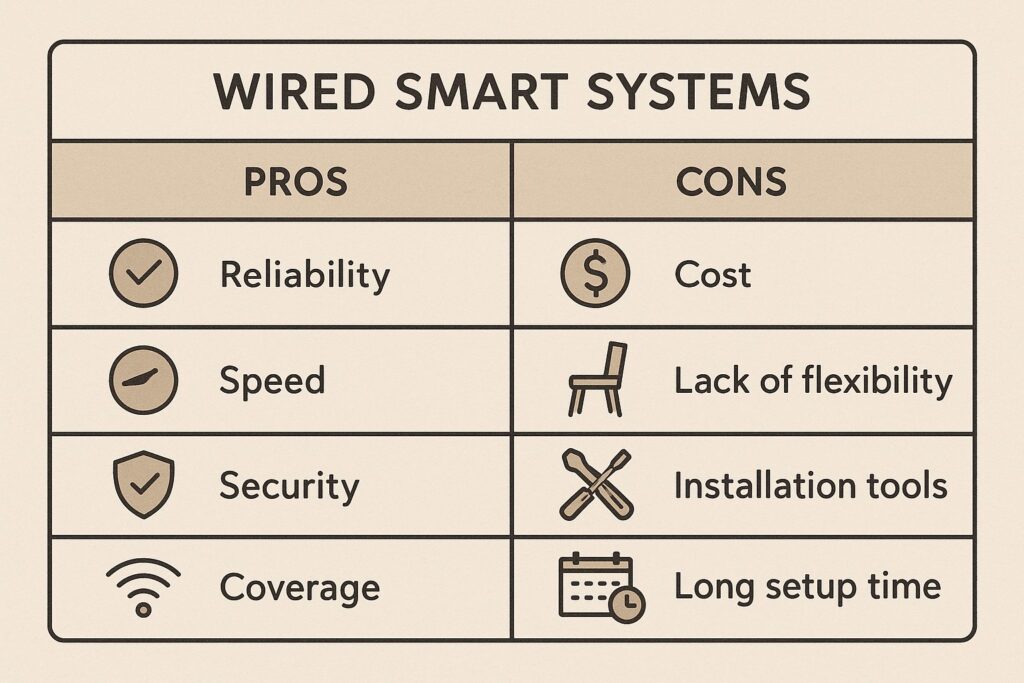
✅ Pros of Wired Smart Systems
Rock-Solid Reliability
Since wired systems use physical connections, they’re immune to common wireless issues like signal drops, interference, or lag. This is especially important for critical smart home functions like security systems, smart locks, and surveillance cameras.
Faster and Stable Data Transfer
Wired connections, such as Ethernet-based smart home setups, offer faster and more consistent data speeds. That means smoother video feeds, quicker response times, and minimal latency in your device commands.
Enhanced Security and Privacy
Wired systems are harder to hack because there’s no wireless signal to intercept. This makes them ideal for users with high-security concerns or those who prioritize smart home data protection.
Ideal for Large or Multi-Story Homes
In larger homes, wireless signals often struggle to cover every corner. With a wired system, every room can be hardwired into your smart home infrastructure, ensuring full-home coverage without needing mesh networks or range extenders.
❌ Cons of Wired Smart Systems
Expensive Installation
Running cables through walls, floors, or ceilings can get pricey—especially if you’re retrofitting an existing home. You’ll likely need a professional installer, which adds to the overall cost of setup.
Less Flexible or Scalable
Wired systems don’t adapt easily. Want to add a new smart thermostat or camera? You may need to open walls or add new wiring. This limits how quickly you can scale or upgrade your smart home over time.
Not Ideal for Renters or Temporary Spaces
If you’re renting or planning to move, a wired system may not be worth the investment. It’s much harder to uninstall and move compared to wireless smart home setups.
Longer Setup Time
Even a basic wired smart home can take days (or weeks) to install depending on the home layout. Unlike plug-and-play systems, you’ll need to plan carefully before any device is activated.
Pros and Cons of Wireless Smart Systems
Wireless smart systems have quickly become the go-to choice for most homeowners—and for good reason. They’re easy to install, flexible, and perfect for growing your smart home one device at a time. But like any tech setup, they also come with limitations you should be aware of.
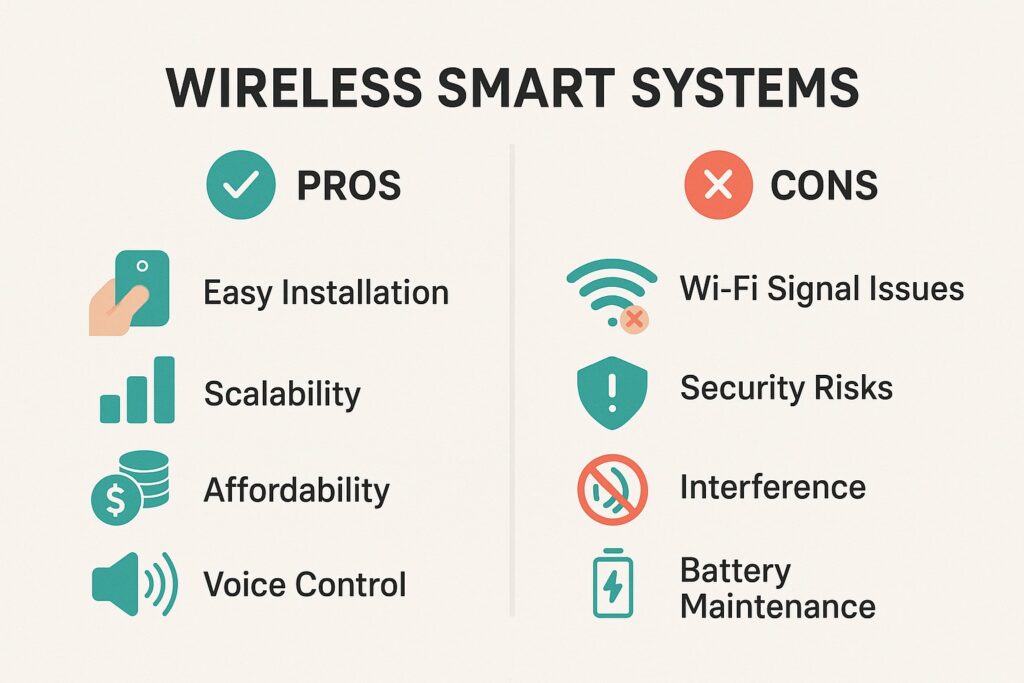
Let’s break down the main advantages and disadvantages of wireless smart home systems to help you make a smart, informed choice.
✅ Pros of Wireless Smart Systems
Easy to Install, No Drilling Required
Wireless systems are plug-and-play smart solutions. You don’t need to tear up your walls or run cables—just connect your devices to Wi-Fi, pair them with an app, and you’re good to go. Perfect for renters, small homes, or anyone who prefers a hassle-free setup.
Highly Scalable and Modular
One of the biggest perks is how scalable these systems are. Want to add a new smart plug or camera? You can do it in minutes. This makes wireless smart systems great for people who want to start small and expand later.
Lower Upfront Costs
Unlike wired systems that may require professional installation, wireless devices are often more budget-friendly and easier to install yourself. Many top-rated smart devices are affordable and available in bundles or starter kits.
Compatible with Voice Assistants and Apps
Most wireless devices work seamlessly with Google Assistant, Alexa, or Apple HomeKit, letting you control your home with your voice or phone. You’ll also find broad support for automation platforms like SmartThings or IFTTT.
❌ Cons of Wireless Smart Systems
Dependent on Wi-Fi Quality
The biggest drawback is that wireless smart devices rely on your home Wi-Fi network. If your signal is weak, spotty, or overloaded, devices may disconnect or lag—especially in larger homes.
More Vulnerable to Security Risks
Because they operate over wireless signals, these systems can be more susceptible to hacking and cyber threats if not properly secured. Using strong passwords, network encryption, and secure apps is essential.
Interference and Signal Dropouts
Wireless signals can face interference from other devices (like microwaves, baby monitors, or neighboring networks), leading to unreliable performance. Zigbee and Z-Wave protocols help reduce this, but issues can still arise.
Battery Maintenance for Some Devices
Many wireless sensors or cameras are battery-powered. That means you’ll need to keep track of battery life and replace or recharge them regularly—a small hassle, but worth noting.
Which System Is Best for You? (Use Case Breakdown)
Choosing between a wired vs wireless smart system isn’t just about tech specs—it’s about your lifestyle, home type, budget, and long-term goals. To help you make the right decision, here’s a practical breakdown of which system works best for different situations.
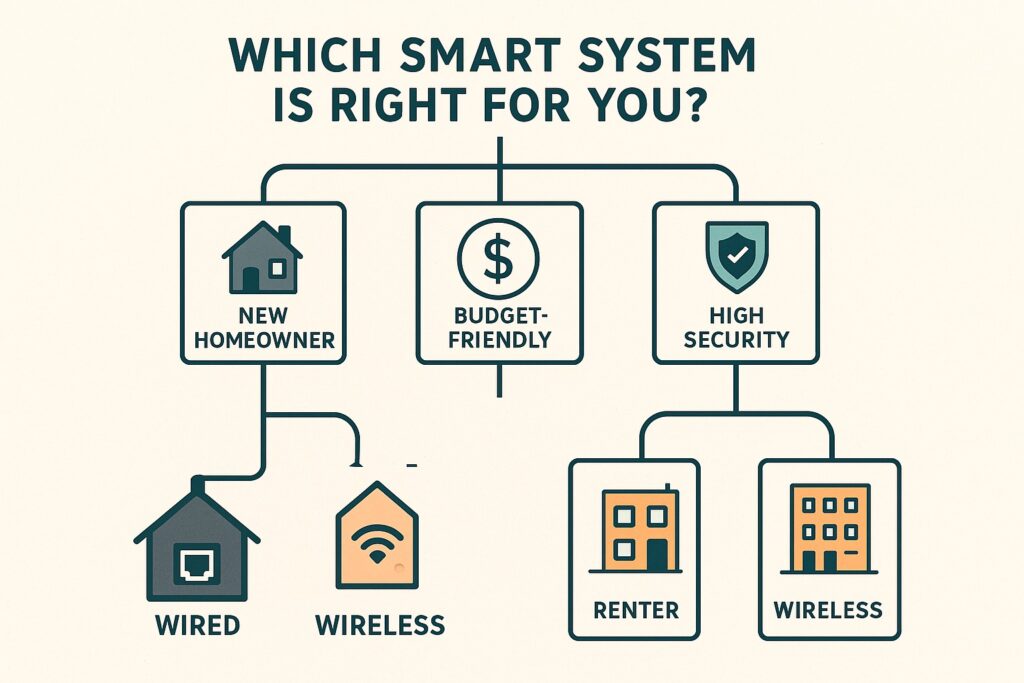
🏠 For Homeowners Building from Scratch
If you’re building a new home or doing a major renovation, a wired smart home system is a strong investment. You can lay structured cabling behind the walls and integrate everything—lights, cameras, thermostats—into one unified, centralized automation system. This setup offers long-term reliability, professional-grade security, and seamless control.
Best Fit: Wired
🛋️ For Renters or Small Apartments
Wired systems aren’t practical if you’re renting or living in a small space. That’s where wireless smart systems shine. They’re easy to install, move with you, and don’t require any drilling or rewiring. Plus, you can control everything from your phone or voice assistant.
Best Fit: Wireless
💰 For Budget-Conscious Smart Home Setups
If you’re on a budget or just getting started, wireless systems are the way to go. You can start with a few affordable devices—like a smart plug, bulb, or security camera—and build your setup as you go. No need for professional installers or expensive infrastructure.
Best Fit: Wireless
🔐 For High-Security or Mission-Critical Installations
Have a large property, sensitive data, or a need for 24/7 surveillance? A wired system is ideal here. These setups are less vulnerable to hacking, don’t rely on Wi-Fi, and offer a stable connection that won’t drop when you need it most. Great for businesses, remote offices, or high-security homes.
Best Fit: Wired
🔁 For Flexible, Evolving Setups
If you like upgrading your tech regularly or plan to keep expanding your system, wireless smart devices give you the freedom to do that without hassle. Most are modular and scalable, letting you mix and match devices as needed.
Best Fit: Wireless
Hybrid Smart Systems: The Best of Both Worlds?
If you’re torn between a wired and a wireless setup, there’s good news—you don’t have to choose just one. A hybrid smart system gives you the flexibility to combine both approaches, using wired connections where stability is critical and wireless devices where flexibility and convenience matter most.
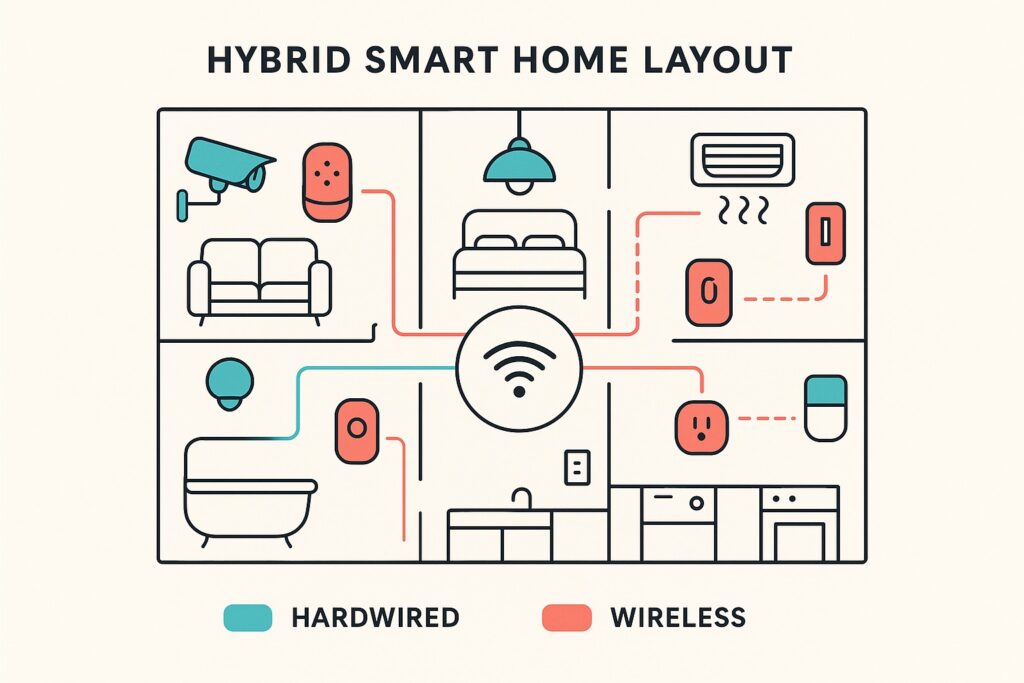
🧠 What Is a Hybrid Smart Home System?
A hybrid system blends the reliability of wired connections with the scalability of wireless devices. For example, you might hardwire your security cameras, alarm system, and smart lighting for rock-solid performance, while using wireless options like voice assistants, smart plugs, and door sensors where mobility and easy upgrades are needed.
This setup is especially useful in larger homes or smart homes with complex needs, where no single approach fits all. It gives you the best of both worlds: stability where you need it, and flexibility where you want it.
⚙️ When to Choose a Hybrid Setup
A hybrid smart system is a great option if:
- You’re doing partial renovations and want to hardwire key systems but keep some wireless elements for convenience.
- You want a more secure setup for surveillance, but still need wireless devices for less critical tasks.
- Your home already has some smart devices, and you’re expanding into wired automation gradually.
It allows you to future-proof your smart home while still enjoying quick upgrades and device additions.
Final Verdict: Wired vs Wireless for the Future
So, which smart system wins the battle—wired or wireless? Honestly, the answer depends on your needs, your home, and how you see your smart lifestyle evolving.
If you value stability, security, and long-term investment, especially in a home you own or are building from scratch, a wired smart home system is a solid bet. It offers reliable performance, minimal lag, and peace of mind—perfect for high-security features like surveillance cameras and smart locks that you want working 24/7.
But if you want flexibility, convenience, and affordability, or you’re just starting out in the smart home world, wireless smart systems are the future-forward option. They’re easy to install, budget-friendly, and can grow with you. Whether it’s controlling your lights with your voice, or managing your devices from an app while you’re away, wireless tech keeps getting smarter, faster, and more secure.
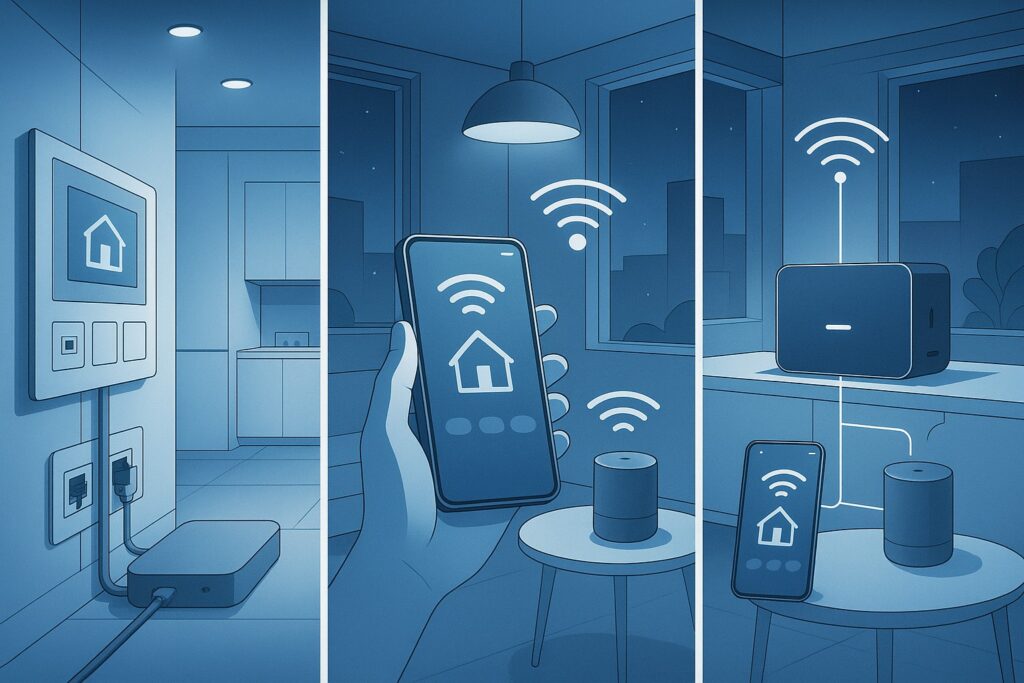
For many homeowners, the future actually lies in a hybrid smart system—a strategic blend of both worlds. Wired where it counts, wireless where it’s convenient. It gives you the ability to customize your setup based on your current lifestyle while staying flexible for what comes next.
In the end, it’s not just about choosing technology—it’s about choosing what works best for your home, your budget, and your future plans.
FAQs: Wired vs Wireless Smart Systems
Yes. Wired smart systems offer more stable and interference-free connections compared to wireless setups. They’re ideal for critical tasks like security, surveillance, and automation that need consistent performance.
While wireless smart home systems are more exposed to cyber threats, using strong passwords, network encryption (WPA3), and two-factor authentication significantly reduces the risk. Always keep your firmware and apps up to date.
Switching from wireless to wired can be done during a renovation or new construction, but it’s often costly and disruptive. A better option for most homeowners is a hybrid system that combines both technologies.
Yes, in most cases. Installing a wired automation system typically involves running cables through walls and connecting centralized hubs. Hiring a professional ensures the setup is safe, efficient, and future-proof.
Conclusion
Choosing between wired and wireless smart systems doesn’t have to be overwhelming. If you want long-term stability and top-tier security, wired systems are your best bet. If you value flexibility, ease of use, and lower upfront costs, wireless systems will serve you well. And if you’re looking for a balance of both, a hybrid smart system is a powerful solution.
👉 Ready to build your smart home? Start with what matters most to you—then expand your system at your own pace. Whether you go wired, wireless, or hybrid, the key is to make your smart home truly smart for your lifestyle.
📋 Smart System Decision Checklist
| Question | Answer Options | Your Pick ✅ |
|---|---|---|
| Are you building or renovating your home? | Yes → Go WiredNo → Go Wireless or Hybrid | |
| Do you need strong, uninterrupted performance (e.g., cameras, alarms)? | Yes → Go WiredNo → Go Wireless | |
| Do you rent or plan to move within a few years? | Yes → Go WirelessNo → Go Wired or Hybrid | |
| Is your Wi-Fi signal weak or inconsistent in some areas? | Yes → Go Wired or HybridNo → Go Wireless | |
| Do you want to install everything yourself without professionals? | Yes → Go WirelessNo → Go Wired or Hybrid | |
| Is security and data privacy a top concern for you? | Yes → Go WiredNo → Wireless + extra protection | |
| Do you plan to scale or upgrade your system regularly? | Yes → Go Wireless or HybridNo → Go Wired | |
| Are you working with a limited budget right now? | Yes → Go WirelessNo → Choose Based on Needs |
🎯 Download This Smart System Checklist (PDF)
Print it, fill it out, and make your smart home decision with confidence! “Download our free checklist to decide which smart system is right for your home!”
You will also like:
- Beginner’s Guide to Smart Homes
- Top Smart Devices for First-Time Users
- How to Set Up a Smart Home Network
- Zigbee vs Z-Wave: What’s the Difference?
- How to Secure Your Smart Home from Hackers
- What is a smart home?

